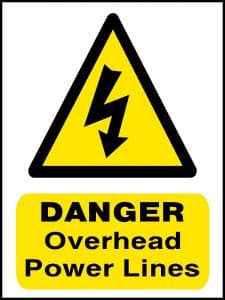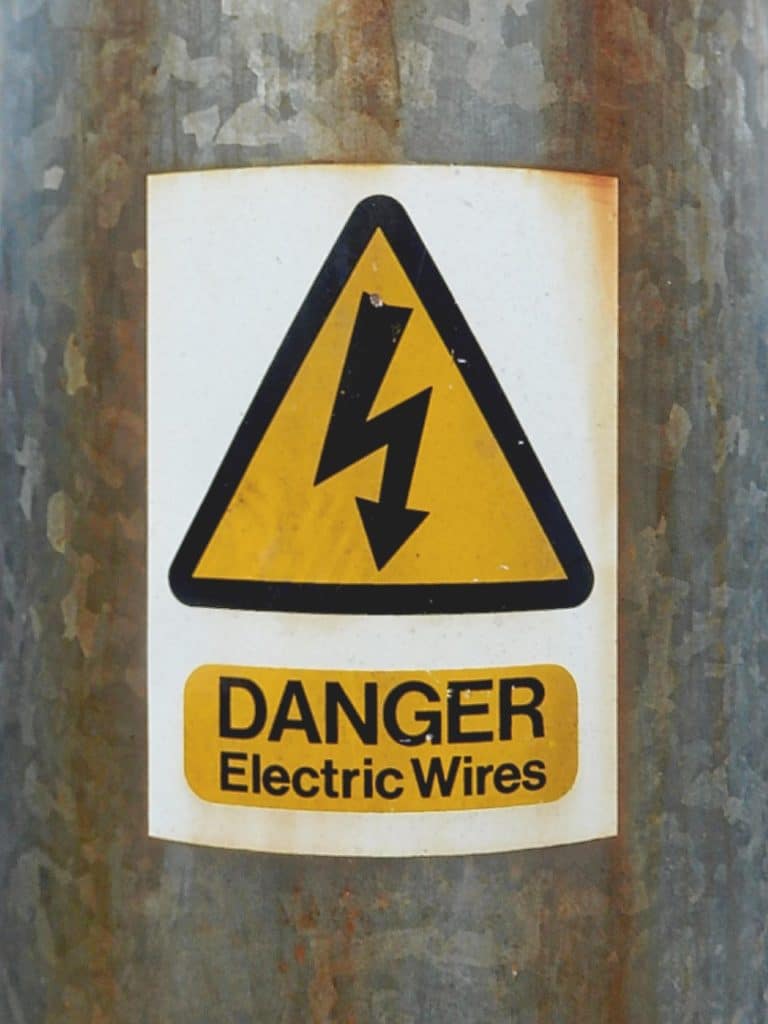Electric shock prosecutions by the Health and Safety Executive (HSE) highlight the dangers of working near overhead power cables. A construction company and two workers have been sentenced after a worker suffered an electric shock whilst working on a farm.
On 30 September 2019 an employee of Connop and Son Limited was working on Worton Grounds Farm, Deddington, Banbury, Oxon and pouring concrete when the floating arm of a mobile concrete pump came into contact with an overhead powerline.
As a result, the employee received an 11,000-volt shock which caused him to lose consciousness. His colleagues had to perform CPR to resuscitate him at the scene. The man was later taken to Oxford Hospital where he was in a coma for six days and hospitalised for 10 days.
The HSE investigation found that Connop & Son Limited fell far below the expected standard and failed to implement its own control measures documented within its risk assessment. Therefore, the company did not meet the requirements of regulation 14 of the Electricity at Work Regulations 1989.
The HSE investigation also found that Alexander Maddan, a sole trader, failed to plan, manage and monitor the construction phase and failed to ensure reasonably practicable control measures were in place. Additionally, Shaun Walker, a concrete pump operator, failed to take reasonable care for the health and safety of himself and others who were affected by his acts or omissions.
Connop and Son Limited, of Folly Farm, Eardisland, Leominster pleaded guilty to breaching regulation 14 of the Electricity at Work Regulations 1989. The company was fined £50,000 and ordered to pay costs of £5,425 plus a victim surcharge of £181 at Oxford Magistrates’ Court on 28 October 2022.
Alexander Maddan, of Deddington, Banbury, Oxon pleaded guilty to breaching regulation 13 (1) of Construction Design and Management Regulations 2015. Mr Maddan was fined £3,000 and ordered to pay costs of £525 plus a victim surcharge of £181 at Oxford Magistrates’ Court on 28 October 2022.
Shaun Walker, of Swinford Leys, Wombourne, Wolverhampton pleaded guilty to breaching section 7 of the Health and Safety at Work Act. Mr Walker was handed a 12-month community order with a requirement to carry out 60 hours of unpaid work and ordered to pay costs of £2,000 plus a victim surcharge of £90 at Oxford Magistrates’ Court on 28 October 2022.
“Connop and Son Limited, Alexander Maddan and Shaun Walker could have ensured that the mobile concrete pump lorry was positioned outside an exclusion zone to prevent contact with the overhead powerline.
“Companies should be aware that HSE will not hesitate to take appropriate enforcement action against those that fall below the required standards.”
HSE inspector Steve Hull

Electric shock safety guidance
Regulation 14 of the Electricity at Work Regulations 1989, prohibits people working on or near any live conductor (other than one suitably covered with insulating material so as to prevent danger) that danger may arise unless–
- it is unreasonable in all the circumstances for it to be dead; and
- it is reasonable in all the circumstances for him to be at work on or near it while it is live; and
- suitable precautions (including where necessary the provision of suitable protective equipment) are taken to prevent injury.
Employers and the self-employed must take appropriate precautions to safeguard workers and others who may be impacted by their activities. Any work activity to be undertaken near electrical cables must be properly planned and risk assessed with risks eliminated or reduced as far as reasonably practicable.
Accidental contact with live overhead power lines kills people and causes many serious injuries every year. People are also harmed when a person or object gets too close to a line and a flashover occurs. Work involving high vehicles or long equipment is particularly high risk, such as;
In Construction – Lorry mounted cranes (such as Hiabs or Palingers), Mobile Elevated Work Platforms (MEWP’s), scaffold poles, tipper vehicles, cranes, ladders;
In Agriculture – combines, sprayer booms, materials handlers, tipper vehicles, ladders, irrigation pipes, polytunnels;
Those working near overhead powerlines should remember that:
- going close to a live overhead line can result in a flashover that may kill. Touching a power line is not necessary for the danger to occur;
- voltages lower than 230 volts can kill and injure people;
- do not mistake overhead power lines on wooden poles for telephone wires; and
- electricity can bypass wood, plastic or rubber, if it is damp or dirty, and cause fatal shocks. Do not rely on gloves or rubber boots to protect you.
The HSE guidance note “Avoiding danger from overhead power lines” describes how to work safely near overhead power lines in a range of industries.

Planning
Plan and manage work near electric overhead power lines so that risks from accidental contact or close proximity to the lines are adequately controlled. Safety precautions will depend on the nature of the work and will be essential even when work near the line is of short duration.
Safety can be achieved by a combination of measures including:
- Planning and preparation
- Eliminating the danger
- Controlling the access
- Controlling the work
Planning and preparation
The first step is to find out whether there is any overhead power line within or immediately next to the work area, or across any access route. Information will be available from the local electricity supplier or Distribution Network Operator (DNO). If any overhead lines are found, you should assume that they are live unless proved otherwise by their owners.
If there are any overhead lines over the work area, near the site boundaries, or over access roads to the work area, consult the owners of the lines so that the proposed plan of work can be discussed.
Allow sufficient time for lines to be diverted or made dead, or for other precautions to be taken.
Eliminating the danger
You can eliminate the danger by:
- Avoidance – find out if the work really has to be carried out under or near overhead lines, and cannot be done somewhere else. Make sure materials (such as bales or spoil) are not placed near overhead lines, and temporary structures (such as polytunnels) are erected outside safe clearance distances;
- Diversion – arrange for overhead lines to be diverted away from the work area; or Isolation – arrange for lines to be made dead while the work is being done.
In some cases you may need to use a suitable combination of these measures, particularly where overhead lines pass over permanent work areas. If the danger cannot be eliminated, you should manage the risk by controlling access to, and work beneath, overhead power lines.
Controlling the access
Where there is no scheduled work or requirement for access under the lines, barriers should be erected at the correct clearance distance away from the line to prevent close approach. The safe clearance distance should be ascertained from the Distribution Network Operator (DNO). HSE guidance documents Avoidance of danger from overhead electric power lines and Electricity at Work: Forestry and Arboriculture also provide advice on safe clearance distances and how barriers should be constructed. Where there is a requirement to pass beneath the lines, defined passageways should be made and clearly delineated.
The danger area should be made as small as possible by restricting the width of the passageway to the minimum needed for the safe crossing of plant. The passageway should cross the route of the overhead line at right angles if possible.
Controlling the work
If work beneath live overhead power lines cannot be avoided, barriers, goal posts and warning notices should be provided. Where field work is taking place, it may be impractical to erect barriers and goal posts around the overhead lines – these are more appropriate for use at gateways, on tracks and at access points to farmyards. The following precautions may also be needed to manage the risk:
- Clearance – the safe clearance required beneath the overhead lines should be found by contacting the Distribution Network Operator (DNO);
- Exclusion – vehicles, plant, machinery, equipment, or materials that could reach beyond the safe clearance distance should not be taken near the line;
- Modifications – Vehicles such as cranes, excavators and tele-handlers should be modified by the addition of suitable physical restraints so that they cannot reach beyond the safe clearance distances, measures should be put in place to ensure these restraints are effective and cannot be altered or tampered with;
- Maintenance – operators of high machinery should be instructed not carry out any work on top of the machinery near overhead power lines;
- Supervision – access for plant and materials and the working of plant should be under the direct supervision of a suitable person appointed to ensure that safety precautions are observed.
What to do if you come into contact with an OHPL
- If part of a vehicle or load is in contact with an OHPL, you should remain in the cab and inform the Distribution Network Operator (DNO) immediately (stick the number in a visible place in the cab and keep it on your mobile phone).
- Warn others to stay away.
- Try to drive clear. If this is not possible, and you need to leave the vehicle to escape fire, JUMP CLEAR – do not dismount by climbing down the steps.
- Never try to disentangle equipment until the owner of the line has confirmed that it has been de-energised and made safe.
Contact with an overhead power line may cause the power to ‘trip out’ temporarily and it may be re-energised automatically, without warning. Your local Distribution Network Operator (DNO) can generally supply stickers describing emergency procedures and containing contact numbers that can be stuck in the cabs of vehicles likely to be used near overhead power lines.
The leaflet called Safe working near overhead power lines in agriculture and the Electricity Networks Association (ENA) publications Safety Information for Farmers and Agricultural Contractors and Watch It! In the Vicinity of Overhead Lines provide advice on what to do if machinery or equipment comes into contact with an overhead power line.
If you require health and safety advice for your business, please contact one of the Ashbrooke team.



